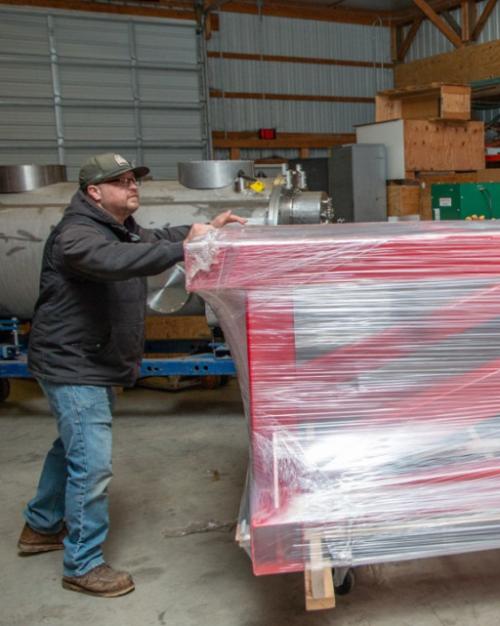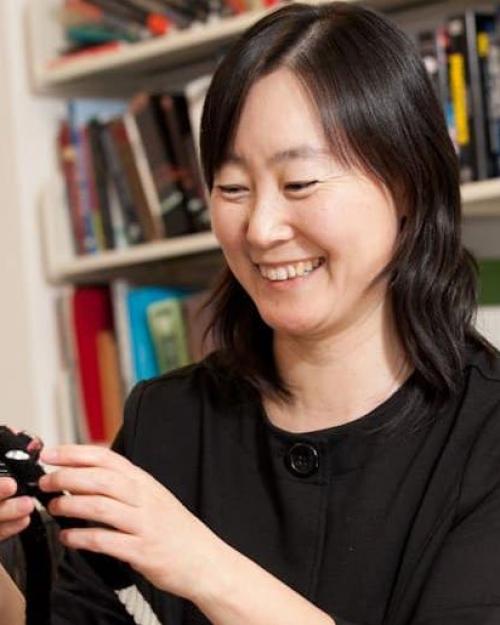Right now, as you read this, countless motor proteins responsible for gene expression and replication are traveling the double helixes of your cells’ DNA. They move along the DNA strands as if on a molecular highway, carrying out fundamental biological processes such as transcribing genes and duplicating your DNA during cell division. As they do this, they also distort the DNA highway.
“Because of the helical nature of DNA, as a motor protein moves forward, it must rotate around the helical axis,” says Michelle D. Wang, Physics. “This rotational motion is intrinsic to the motor protein’s properties, and it causes the DNA to deform, to reconfigure. But how powerful are motor proteins? How much torque can they generate? These are questions that are very mechanical in nature, very suited to a physicist like myself.”
Creating an Angular Optical Trap
To explore the mechanics of DNA winding and unwinding, the Wang lab has developed a cutting-edge tool known as an Angular Optical Trap (AOT), which traps a nanofabricated quartz cylinder and measures the torque on the cylinder. The AOT adds a new dimension to conventional optical tweezers, which were invented by Cornell graduate and Nobel Prize-winner Arthur Ashkin, PhD Physics ’52. Conventional optical tweezers use a laser beam to capture and hold a microsphere that can be attached to a single molecule. These tweezers are mostly used for measuring force and distances at the molecular level, but the Wang lab wondered whether an AOT could be applied to the study of a biological system’s rotational motions.
“To rotate the cylinder, we simply rotate the polarization of the trapping laser, and we measure the torque exerted on the cylinder by the change in the angular momentum of the transmitted light,” Wang says. “If the cylinder is attached to a DNA molecule, for instance, we can then use the AOT to directly measure the torque it takes to twist the DNA.”
Measuring the Torsional Power of RNAP
Using the AOT, the researchers carried out a number of projects seeking to measure, control, and ultimately understand DNA torques. In one project, they looked at how RNA polymerase (RNAP)—a motor protein responsible for copying DNA to RNA during transcription—becomes stalled when working against torsional stress. They found that RNAP is a powerful torsional motor, capable of generating enough torque to denature, or melt, DNA.
“Historically, people thought that enzymes called topoisomerases would always relax the torsional stress and solve these topological problems,” Wang says. “But recent studies show that this is not the case, and topoisomerases are not always able to keep up. So we wanted to investigate whether there were other ways to allow gene expression and DNA replication to proceed that don’t rely on topoisomerases.”
During replication, the helical nature of DNA can cause the two daughter DNA strands to become intertwined, preventing separation of chromosomes during cell division. True to their physicist backgrounds, Wang and her lab colleagues took a mechanical approach to the question of how DNA entanglement is limited during replication. They looked at the torsional stiffness, or resistance to twist, of the chromatin substrate—the DNA and protein that make up a chromosome—both in front of the replication fork and behind it. “We asked what chromatin’s role is in dictating where the extra twist is going to locate during DNA replication,” Wang says.
If the extra twist happens behind the fork, the two daughter DNA molecules will become entangled, interfering with chromosome separation. Whereas, if it happens in front of the fork, chromosomes are not intertwined. “We found that chromatin plays a very important role in minimizing topological complications because a single chromatin fiber is easier to twist than a double chromatin fiber,” Wang explains. “This property helps relieve the torsional stress on the substrate, making it easier for chromosome separation to take place because the extra twist during replication will go to the front of the fork and minimize the entanglement of the daughter strands.”
“We take a DNA molecule and we very quickly unzip it, breaking apart all the DNA base pairs. We unzip right through the [motor] proteins to map out where they are along the DNA.”
Unzipping DNA
The Wang lab is also interested in how various motor proteins coordinate and navigate as they move forward along DNA. To study DNA-protein interactions, the lab has pioneered three different techniques based on DNA unzipping, the mechanical separation of the DNA double strand into two individual strands.
The first technique, known as the unzipping mapper, allows the researchers to pinpoint the location of specific proteins. “We take a DNA molecule and we very quickly unzip it, breaking apart all the DNA base pairs,” Wang explains. “We unzip right through the [motor] proteins to map out where they are along the DNA. We are able to do this very precisely. We can tell where a protein is, to better than a base pair. Once we know where they are, we can study their structure, their interactions.”
Using another technique, the unzipping tracker, the researchers can follow a motor protein traveling along the DNA. Finally, with the unzipping staller, they can stall a motor protein and study how it overcomes the obstacle.
In one project Wang and her collaborators looked at the interactions between RNAP and the motor protein Mfd, which is known to be important for DNA damage repair. Using the unzipping tracker, they investigated whether Mfd is able to move about on the DNA highway. “Everybody thought Mfd doesn’t move on its own,” Wang says. “We found that it actually moves bi-directionally on the DNA, and through that, we discovered how it locates a stalled RNAP.”
The researchers found that Mfd travels in short bursts, interspersed with periods when it removes itself from the DNA completely. “So Mfd can scan the DNA in surges, surveying what’s on the road, basically, and then find the RNAP that is stalled,” Wang explains. “If the RNAP is completely unable to move forward, the Mfd will move it off the DNA. But if the RNAP is just a little bit stuck, the Mfd pushes it forward to resume transcription.”
Anticancer Drugs and Topoisomerases
While Wang’s research tends to be basic science, exploring how DNA transcription and replication processes work, she is also looking at how various anticancer drugs affect topoisomerases. “Many of these drugs target topoisomerases because the enzymes are essential for DNA replication,” she says. “We have the tools to study topoisomerases and how the drugs interfere with them. By having a better understanding of that, we can potentially help other people to design drugs that are more effective and more specific.”




